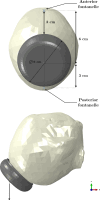Computational modeling of vacuum-assisted delivery: biomechanics of maternal soft tissues
- PMID: 40536739
- PMCID: PMC12245992
- DOI: 10.1007/s10237-025-01977-0
Computational modeling of vacuum-assisted delivery: biomechanics of maternal soft tissues
Abstract
Childbirth is a complex process influenced by physiological, mechanical, and hormonal factors. While natural vaginal delivery is the safest, it is not always feasible due to diverse circumstances. In such cases, assisted delivery techniques, such as vacuum-assisted delivery (VAD), may facilitate vaginal birth. However, this technique can be associated with a higher risk of maternal injuries, potentially resulting in long-term conditions such as pelvic organ prolapse or incontinence. This study investigates the biomechanical impact of VAD on maternal tissues, aiming to reduce these risks. A finite element model was developed to simulate VAD, incorporating maternal musculature, a deformable fetal head, and a vacuum cup. Twelve simulations were conducted, varying contraction durations, resting intervals, and the number of pulls required for fetal extraction. Results revealed that prolonged contraction durations, coupled with extended resting intervals, lead to a reduction in pelvic floor stress. Elevated stress levels were observed when fetal extraction involved two pulls, with an 8.43% decrease in maximum stress from two pulls to four. The peak stress recorded was 0.81 MPa during a 60-second contraction, followed by a 60-second rest period. These findings indicate that longer maneuvers may reduce trauma, as extended pulls allow muscles more time to relax and recover during both contraction and rest phases. Furthermore, an increased number of pulls extends the duration of the maneuver, facilitating fetal rotation and improved adjustment to the birth canal. This study offers crucial insights into the biomechanics of childbirth, providing clinicians with valuable information to enhance maternal outcomes and refine assisted delivery techniques.
Keywords: Assisted delivery simulations; Finite element method; Pelvic floor dysfunctions; Perineal injuries; Vacuum cup.
© 2025. The Author(s).
Conflict of interest statement
Declarations. Conflict of interest: The authors declare no conflict of interests.
Figures










Similar articles
-
Use of endoanal ultrasound for reducing the risk of complications related to anal sphincter injury after vaginal birth.Cochrane Database Syst Rev. 2015 Oct 29;2015(10):CD010826. doi: 10.1002/14651858.CD010826.pub2. Cochrane Database Syst Rev. 2015. PMID: 26513224 Free PMC article.
-
Instruments for assisted vaginal birth.Cochrane Database Syst Rev. 2021 Sep 24;9(9):CD005455. doi: 10.1002/14651858.CD005455.pub3. Cochrane Database Syst Rev. 2021. PMID: 34559884 Free PMC article.
-
Pushing/bearing down methods for the second stage of labour.Cochrane Database Syst Rev. 2015 Oct 9;(10):CD009124. doi: 10.1002/14651858.CD009124.pub2. Cochrane Database Syst Rev. 2015. Update in: Cochrane Database Syst Rev. 2017 Mar 26;3:CD009124. doi: 10.1002/14651858.CD009124.pub3. PMID: 26451755 Updated.
-
Biomechanical Impact of Recurrent Childbirth on the Female Pelvic Floor.Int J Numer Method Biomed Eng. 2025 Jul;41(7):e70053. doi: 10.1002/cnm.70053. Int J Numer Method Biomed Eng. 2025. PMID: 40635320
-
Maternal and neonatal outcomes of elective induction of labor.Evid Rep Technol Assess (Full Rep). 2009 Mar;(176):1-257. Evid Rep Technol Assess (Full Rep). 2009. PMID: 19408970 Free PMC article.
References
-
- Angioli R, Gómez-Marín O, Cantuaria G, O’Sullivan MJ (2000) Severe perineal lacerations during vaginal delivery: the University of Miami experience. Am J Obstet Gynecol 182(5):1083–1085. 10.1067/mob.2000.105403 - PubMed
-
- Ami O, Maran J, Moyal M, Musset D, Frydman R, Boyer L, Mage G (2016) 3D MRI imaging during the 2nd phase of labor and delivery: fetal heald molding. Eur J Obstet & Gynecol Reprod Biol 206:88. 10.1016/j.ejogrb.2016.07.236
-
- Buttin R, Zara F, Shariat B (2013) Biomechanical simulation of the fetal descent without imposed theoretical trajectory. Comput Methods Programs Biomed 111:389–401. 10.1016/j.cmpb.2013.04.005 - PubMed
-
- Chill HH, Dick A, Zarka W, Vilk Ayalon N, Rosenbloom JI, Shveiky D, Karavani G (2024) Factors Associated with Obstetric Anal Sphincter Injury During Vacuum-Assisted Vaginal Delivery. Int Urogynecol J 35(6):1183–1189. 10.1007/s00192-024-05785-5 - PubMed
MeSH terms
Grants and funding
LinkOut - more resources
Full Text Sources

